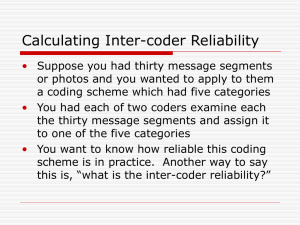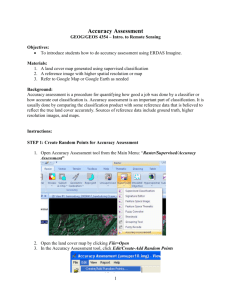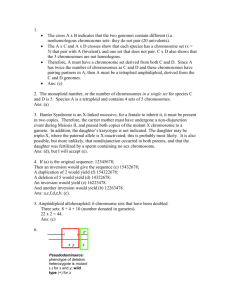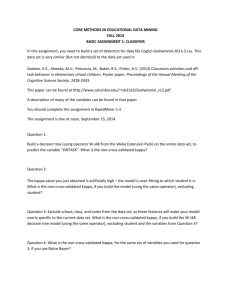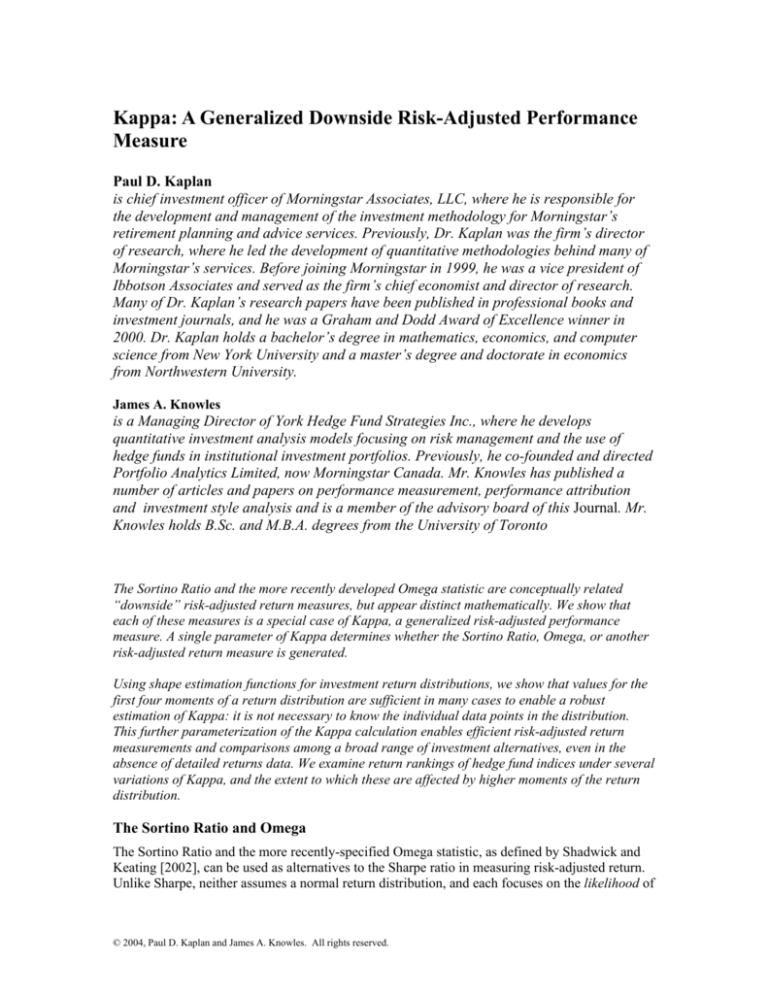
Kappa: A Generalized Downside Risk-Adjusted Performance
Measure
Paul D. Kaplan
is chief investment officer of Morningstar Associates, LLC, where he is responsible for
the development and management of the investment methodology for Morningstar’s
retirement planning and advice services. Previously, Dr. Kaplan was the firm’s director
of research, where he led the development of quantitative methodologies behind many of
Morningstar’s services. Before joining Morningstar in 1999, he was a vice president of
Ibbotson Associates and served as the firm’s chief economist and director of research.
Many of Dr. Kaplan’s research papers have been published in professional books and
investment journals, and he was a Graham and Dodd Award of Excellence winner in
2000. Dr. Kaplan holds a bachelor’s degree in mathematics, economics, and computer
science from New York University and a master’s degree and doctorate in economics
from Northwestern University.
James A. Knowles
is a Managing Director of York Hedge Fund Strategies Inc., where he develops
quantitative investment analysis models focusing on risk management and the use of
hedge funds in institutional investment portfolios. Previously, he co-founded and directed
Portfolio Analytics Limited, now Morningstar Canada. Mr. Knowles has published a
number of articles and papers on performance measurement, performance attribution
and investment style analysis and is a member of the advisory board of this Journal. Mr.
Knowles holds B.Sc. and M.B.A. degrees from the University of Toronto
The Sortino Ratio and the more recently developed Omega statistic are conceptually related
“downside” risk-adjusted return measures, but appear distinct mathematically. We show that
each of these measures is a special case of Kappa, a generalized risk-adjusted performance
measure. A single parameter of Kappa determines whether the Sortino Ratio, Omega, or another
risk-adjusted return measure is generated.
Using shape estimation functions for investment return distributions, we show that values for the
first four moments of a return distribution are sufficient in many cases to enable a robust
estimation of Kappa: it is not necessary to know the individual data points in the distribution.
This further parameterization of the Kappa calculation enables efficient risk-adjusted return
measurements and comparisons among a broad range of investment alternatives, even in the
absence of detailed returns data. We examine return rankings of hedge fund indices under several
variations of Kappa, and the extent to which these are affected by higher moments of the return
distribution.
The Sortino Ratio and Omega
The Sortino Ratio and the more recently-specified Omega statistic, as defined by Shadwick and
Keating [2002], can be used as alternatives to the Sharpe ratio in measuring risk-adjusted return.
Unlike Sharpe, neither assumes a normal return distribution, and each focuses on the likelihood of
© 2004, Paul D. Kaplan and James A. Knowles. All rights reserved.
not meeting some target return. In contrast Sharpe measures only the sign and magnitude of the
average risk premium relative to the risk incurred in achieving it.
As specified, the Sortino Ratio and Omega appear distinct. Omega is defined as:
∞
Ω ( τ) =
∫ [1 − F(R)]dR
τ
τ
(1)
∫ F(R)dR
−∞
where
F(.)
τ
= the cumulative density function (cdf) for total returns on an investment
= threshold return
The Sortino Ratio is defined as:
µ−τ
S=
τ
∫ (τ − R)
2
(2)
dF ( R )
−∞
where
∞
µ
= the expected periodic return =
∫ RdF(R)
−∞
Despite their apparent distinctiveness, Omega and the Sortino Ratio each represent a single case
of a more generalized risk-return measure, defined below, which we call Kappa (K). Kn generates
Omega when n=1, the Sortino Ratio when n=2, or any of an infinite number of related risk-return
measures when n takes on any positive value. Kappa is undefined where n<=0.
Definition of Kappa
Harlow [1991] defines the nth lower partial moment function as
LPM n ( τ ) =
τ
∫ (τ − R)
n
dF ( R )
(3)
−∞
Substituting equation (3) into equation (2) provides an alternative, fully equivalent definition of
the Sortino ratio as
October 2003
2
S=
µ−τ
2
LPM 2 (τ )
(4).
Kappa is a generalization of this quantity, thus:
Kn ( τ) =
µ−τ
n
(5)
LPM n ( τ )
by which definition, the Sortino Ratio is K2(τ), with τ being the investor’s minimum acceptable or
“threshold” periodic return.
Regarding Omega, in Appendix A, we show that
Ω (τ ) =
or, equivalently,
µ−τ
+1
LPM1 (τ )
Ω ( τ ) = K1 ( τ ) + 1
(6a)
(6b)
Hence the Omega statistic and the Sortino ratio have identical structures, being equal to K1+1 and
K2 respectively. Despite the addition of a constant to K1 in the Shadwick and Keating definition
of Omega, Omega and K1 are for all practical purposes identical. We refer to them
interchangeably below1.
Kn is defined for any value of n exceeding zero. Thus, in addition to K1 and K2, any number of Kn
statistics may be applied in evaluating competing investment alternatives or in portfolio
construction.
Discrete Calculation vs. Curve-Fitting
The lower partial moment required to calculate Kappa can be estimated from a sample of actual
returns by treating the sample observations as points in a discrete return distribution. Let
T
Rt
= sample size
= the tth return observation
The estimated nth lower partial moment is
T
n ( τ ) = 1 max [ τ − R , 0]n
LPM
∑
t
T t =1
1
(7)
Kazemi, Schneeweis, and Gupta [2003] define a quantity that is similar to K1 that they
call the “Sharpe-Omega ratio.”
October 2003
3
This is a straightforward calculation but requires knowledge of the individual observations of the
return sample. For obvious reasons relating to data availability, management and storage
requirements, as well as for modeling and forecasting purposes, it would be useful to be able to
calculate Kappa from a small number of return distribution characteristics rather than from raw
data.
An alternative approach to estimating LPMn(τ) is to assume that returns follow a particular
continuous distribution and calculate the integral in equation (3) accordingly. For example, when
estimating LPM2(τ), Sortino [2001] and Forsey [2001] assume that returns follow the threeparameter lognormal distribution defined by Aitchinson and Brown [1957]. The three parameters
of the distribution can be set so that the first three moments, mean (µ), standard deviation (σ), and
coefficient of skewness (s) of the distribution match a given set of values.
For the three-parameter lognormal distribution, the fourth moment, the coefficient of kurtosis (κ),
is a function of s. We show this relationship in Figure 1. However, the value of κ required to
accurately represent the return distribution could in reality be higher or lower than the value
implied by the three-parameter lognormal distribution. Johnson [1949] describes a three-member
“family” of four-parameter distribution functions, including bounded and unbounded curves in
addition to the three-parameter lognormal. Hill, Hill and Holder [1976] (hereafter HHH) extend
the Johnson family of functions by adding the normal distribution, and provide an algorithm for
selecting the appropriate function and estimating its parameters based on given values of the first
four moments. We describe the extended Johnson family of distribution functions in Appendix
B2.
Figure 1: Skewness vs. Kurtosis, 3-Parameter Lognormal Distribution
Assumed Kurtosis Coefficient
25
20
15
10
5
0
-4
-3
-2
-1
0
1
2
3
4
Skewness Coefficient
Using the HHH algorithm, we create a continuous return distribution from the values of µ, σ, κ
and s. Using the resulting distribution function, we estimate LPMn(τ) by calculating the integral
in equation (3) using the numerical techniques described by Press et al. [1992].
2
Kazemi, Schneeweis, and Gupta [2003] use an approximation of the Johnston
distributions, but in a form that can result in the density function taking on negative
values.
October 2003
4
Johnson distribution functions have been used in other financial applications in a similar fashion.
For example, Posner and Milevsky [1998] use Johnson functions to represent security price
distributions and use them in integral formulas for pricing exotic options.
Testing Kappa Calculations Based On Fitted Curves
To evaluate how closely Kappa values derived from return distribution parameters match those
derived from actual return data, K1 and K2 are calculated for 11 HFR monthly hedge fund
indexes3 for the period January 1990 through February 2003 (“the sample period”), using both
actual return data and curves fitted as described above. Hedge fund indexes are used because they
represent a broad spectrum of distribution shapes.
Distribution moments for the indexes are summarized in Table 1:
Table 1: Kappa Input Parameters of HFR Hedge Fund Indexes
Index
HFR Convertible Arbitrage
HFR Distressed Securities
HFR Emerging Markets
HFR Equity Hedge
HFR Equity Market Neutral
HFR Equity Non-hedge
HFR Event-Driven
HFR Fixed Income Arbitrage
HFR Fund of Funds
HFR Merger Arbitrage
HFR Short Selling
Average Monthly
Excess Return
0.550
0.756
0.763
1.026
0.426
0.861
0.737
0.310
0.434
0.491
0.131
Standard
Deviation
0.994
1.835
4.533
2.678
0.914
4.276
1.977
1.335
1.700
1.284
6.523
Coeff. of
Skewness
-1.341
-0.675
-0.747
0.132
0.036
-0.499
-1.387
-1.644
-0.305
-2.977
0.042
Coeff. Of
Kurtosis
6.064
8.464
6.448
4.172
3.388
3.452
7.761
11.626
6.966
16.304
4.124
K1 and K2 values for the indices, calculated using both discrete data and Johnson distribution
functions estimated from the parameters above, appear in Tables 2a and 2b. Note that excess
returns rather than raw returns are used; hence, a threshold value of τ = 0.0 implies a target return
equal to the risk-free rate.
Table 2a: Discrete & Parameter-Based Kappa Calculations, τ = 0.0% / month
Index
HFR Convertible Arbitrage
HFR Distressed Securities
HFR Emerging Markets
HFR Equity Hedge
HFR Equity Market Neutral
HFR Equity Non-hedge
HFR Event-Driven
HFR Fixed Income Arbitrage
HFR Fund of Funds
HFR Merger Arbitrage
3
K1
Discrete
2.81
2.19
0.56
1.72
2.45
0.64
1.70
0.97
1.03
0.92
K1
ParameterBased
2.70
1.98
0.56
1.73
2.29
0.65
1.55
0.86
0.99
0.85
K1 %
Diff
3.67
9.37
0.36
0.58
6.46
0.93
8.61
12.11
3.41
7.48
K2
Discrete
0.91
0.72
0.25
0.76
1.00
0.31
0.58
0.33
0.43
0.41
K2
ParameterBased
0.94
0.71
0.25
0.76
0.98
0.31
0.57
0.33
0.42
0.40
K2 %
Diff
2.63
1.39
1.20
0.26
1.11
0.32
0.52
1.81
2.34
2.42
Source: Hedge Fund Research, Inc.
October 2003
5
HFR Short Selling
0.50
0.44
13.15
Table 2b: Discrete & Parameter-Based Kappa Calculations,
Index
HFR Convertible Arbitrage
HFR Distressed Securities
HFR Emerging Markets
HFR Equity Hedge
HFR Equity Market Neutral
HFR Equity Non-hedge
HFR Event-Driven
HFR Fixed Income Arbitrage
HFR Fund of Funds
HFR Merger Arbitrage
HFR Short Selling
K1
Discrete
21.255
11.049
1.733
6.239
48.036
1.907
7.337
10.000
8.505
5.781
8.419
K1
ParameterBased
24.824
9.553
1.728
6.264
58.155
1.904
6.613
8.570
7.645
5.170
7.257
K1 %
Diff
16.79
13.54
0.29
0.40
21.07
0.16
9.87
14.30
10.11
10.57
13.80
0.14
0.13
1.48
= -1.0% / month
K2
Discrete
4.632
2.222
0.667
2.109
9.183
0.800
1.745
1.919
2.091
1.836
1.509
K2
ParameterBased
4.811
2.290
0.657
2.087
10.146
0.796
1.789
2.007
2.064
1.858
1.552
K2 %
Diff
3.86
3.06
1.50
1.04
10.49
0.50
2.52
4.59
1.29
1.20
2.85
For the hedge fund indices considered here, the percent differences between Kappa estimates
based on discrete data and parameter-based Kappa estimates increase as τ decreases. These
differences might be material if Kappa were used as an optimization metric, or for stress testing
in a quantitative portfolio construction or asset allocation process. We conclude that parameterbased Kappa estimates should be interpreted with caution when used for these purposes.
However, possibly the commonest use of risk-adjusted performance measures is a simple
comparison of competing investment alternatives. In this context, ranking differences that result
from Kappa estimates based on the two calculation methods are a key consideration. Tables 3a
through 3c show the rankings of the 11 hedge fund indices, for τ values of -1.0% per month, 0.5% per month and 0.0% per month respectively, for K1, K2 and K3 over the sample period:
Table 3a: Index Rankings, Alternative Kappa Calculations, τ = -1.0% / month
HFR Convertible Arbitrage
HFR Distressed Securities
HFR Emerging Markets
HFR Equity Hedge
HFR Equity Market Neutral
HFR Equity Non-hedge
HFR Event-Driven
HFR Fixed Income Arbitrage
HFR Fund of Funds
HFR Merger Arbitrage
HFR Short Selling
Ranking Correlation
October 2003
K1
K2
K3
Discrete
Discrete
Discrete
Data Parameter- Data Parameter- Data ParameterRank Based Rank Rank Based Rank Rank Based Rank
10
10
10
10
10
10
9
9
9
9
8
7
1
1
1
1
1
1
4
4
8
8
9
9
11
11
11
11
11
11
2
2
2
2
2
2
5
5
4
4
4
4
8
8
6
6
5
5
7
7
7
7
6
6
3
3
5
5
7
8
6
6
3
3
3
3
1.000
1.000
0.991
6
Table 3b: Index Rankings, Alternative Kappa Calculations, τ= -0.5% / month
K1
HFR Convertible Arbitrage
HFR Distressed Securities
HFR Emerging Markets
HFR Equity Hedge
HFR Equity Market Neutral
HFR Equity Non-hedge
HFR Event-Driven
HFR Fixed Income Arbitrage
HFR Fund of Funds
HFR Merger Arbitrage
HFR Short Selling
Ranking Correlation
K2
K3
Discrete
Discrete
Discrete
Data Parameter- Data Parameter- Data ParameterRank Based Rank Rank Based Rank Rank Based Rank
10
10
10
10
10
10
9
9
9
9
8
8
1
1
1
1
1
1
4
6
8
8
9
9
11
11
11
11
11
11
2
2
2
2
2
2
7
8
6
7
6
5
8
7
5
5
4
4
5
5
7
6
5
6
3
3
4
4
7
7
6
4
3
3
3
3
0.955
0.991
0.991
Table 3b: Index Rankings, Alternative Kappa Calculations, τ= 0.0% / month
HFR Convertible Arbitrage
HFR Distressed Securities
HFR Emerging Markets
HFR Equity Hedge
HFR Equity Market Neutral
HFR Equity Non-hedge
HFR Event-Driven
HFR Fixed Income Arbitrage
HFR Fund of Funds
HFR Merger Arbitrage
HFR Short Selling
Ranking Correlation
K1
K2
K3
Discrete
Discrete
Discrete
Data Parameter- Data Parameter- Data ParameterRank Based Rank Rank Based Rank Rank Based Rank
11
11
10
10
10
10
9
9
8
8
8
8
2
2
2
2
2
2
8
8
9
9
9
9
10
10
11
11
11
11
3
3
3
3
4
4
7
7
7
7
7
7
5
5
4
4
3
3
6
6
6
6
5
5
4
4
5
5
6
6
1
1
1
1
1
1
1.000
1.000
1.000
Return rankings for the hedge fund indexes are, in general, little affected by the choice of Kappa
estimation methodology. We conclude tentatively that, for the purpose of evaluating competing
investment alternatives, the parameter-based method of estimating Kappa is robust and, where
efficiency and simplicity are important, preferable to the more complex calculation based on
discrete return data. However, more comprehensive tests of this conclusion are needed.
Return rankings are, however, affected materially by the choice of Kappa’s n parameter. Note for
instance that in Table 3b, the ranking of the Equity Hedge index ranges from 4 (K1) to 9 (K3). The
rank of the Short Selling index is 6 under K1 and 3 under K3. These are the only two indices which
combine positive skewness with a kurtosis coefficient of more than 4. In the next section we
examine the relationship between Kappa values, skewness and kurtosis in more detail.
October 2003
7
Table 4 summarizes the index rankings for K1, K2 and K3 at a common return threshold. Note
that, of the eleven indices examined, only two (Emerging Markets and Event-Driven) have
constant ranks across all three Kappa variants. Consider also that these indices, too, might show
ranking changes if other Kappa variants were used.
Table 4: Kappa Rankings of HFR Indices at τ = 0
HFR Convertible Arbitrage
HFR Distressed Securities
HFR Emerging Markets
HFR Equity Hedge
HFR Equity Market Neutral
HFR Equity Non-hedge
HFR Event-Driven
HFR Fixed Income Arbitrage
HFR Fund of Funds
HFR Merger Arbitrage
HFR Short Selling
K1
2.7026
1.9829
0.5610
1.7250
2.2889
0.6497
1.5489
0.8562
0.9906
0.8542
0.4358
K2
0.9383
0.7117
0.2466
0.7566
0.9838
0.3092
0.5721
0.3253
0.4184
0.4033
0.1328
K3
0.5781
0.4204
0.1606
0.5118
0.6714
0.2181
0.3504
0.1951
0.2660
0.2881
0.0769
Rank K1
1
3
10
4
2
9
5
7
6
8
11
Rank K2
2
4
10
3
1
9
5
8
6
7
12
Rank K3
2
4
10
3
1
8
5
9
7
6
12
The existence of substantive ranking differences implies that some Kappa variants may be
superior to others in some circumstances. This has important implications regarding the choice of
Kappa variant when evaluating investment alternatives or constructing a diversified portfolio.
How the most appropriate Kappa variant should be chosen is, unfortunately, less obvious.
Empirical Behavior of Kappa
The Shape of Kappa Curves: All Kappa curves represent an inverse relationship between the
threshold return chosen and the value of Kappa. The steepness of the Kn curve at any given
threshold return is inversely related to the chosen value of the n parameter. Figure 2 shows K1, K2
and K3 curves, relative to threshold return (expressed as a risk premium), for the S&P 500 Index,
for the period January 1990 through February 2003.
October 2003
8
Figure 2: Kappa Value vs. Threshold Risk Premium ($US)
Kappa Curves, S&P 500 Index
0.8
Kappa1 (Omega)
0.6
Kappa2 (Sortino)
Kappa
0.4
Kappa3
0.2
0.0
-0.2
-0.4
-0.6
-0.6 -0.4 -0.2
0.0
0.2
0.4
0.6
0.8
1.0
1.2
1.4
1.6
Threshold Monthly Risk Premium (%)
By construction, every Kappa variant has a value of zero when the threshold return equals the
average figure.
Note that although K2 – the Sortino ratio - is usually expressed as a single-point statistic relative
to a single threshold return, it is more informative to plot this Kappa variant, as well as others,
against a range of threshold values.
All Kappa curves are monotonic. Interpretation of differences in Kn values at different return
thresholds is complex: although the value of K1 at a threshold return of -0.4% is double that of K1
at 0.0%, this does not make K1 (-0.4) twice as “good” as K1 (0.0). Differences between or ratios
of Kappa values at different threshold returns are also dependent on the value of n chosen: the
ratio of Kn (τ) to Kn (τ + 0.75), for the S&P 500 at different values of n, over the S&P sample
period, is shown in the Figure 3. It can be seen that the rate of change in Kappa as a function of τ
is inversely proportional to n.
October 2003
9
Figure 3
Ratio of Kappa Values
5
"n" Parameter
4
3
2
1
Kappa (t = -0.5)
Kappa (t = 0.75)
0
2
3
4
5
Kappa (t) / Kappa (t+0.75)
6
7
We conclude tentatively that Kappa values should be treated as simple ordinals: for a given value
of the n parameter, a higher Kappa is always better than a lower, but the size of the difference
between two Kappa values is not subject to simple interpretation.
Kappa Sensitivity to Skewness: Kappa is insensitive to skewness for values of τ which lie close
to or above the mean return; but sensitive to skewness when τ is substantially below the mean
return. The charts below show the relationship between Kappa and skewness for a return
distribution with a µ = 0.0, σ = 1.0 and κ = 3.0. When τ = -2.0, the ratio of K1 at s = 0.5 to K1 at s
= -0.5 is about 46; the corresponding figures for K2 and K3 are 14 and 10 respectively. Thus,
Kappa sensitivity to skewness, at low values of τ, is a negative function of n, and the n parameter
can be interpreted as a measure of skewness risk “appetite” for threshold returns below the mean.
October 2003
10
Figure 4a: Kappa Sensitivity to Skewness For n = 1, 2 and 3
Kappa vs. Skewness: µ =0, SD=1, K=3, τ = -2.0
10000
Kappa1
Kappa2
1000
Kappa
Kappa3
100
10
1
-0.6
-0.5
-0.4
-0.3
-0.2
-0.1
0
0.1
0.2
0.3
0.4
0.5
0.6
0.5
0.6
Skewness
Figure 4b: K1 Sensitivity to Skewness at Different Return Thresholds
Kappa1 vs. Skewness: µ =0, SD=1, K=3
10000
tau = -2.0
Kappa
1000
tau = -1.0
100
10
1
-0.6
-0.5
-0.4
-0.3
-0.2
-0.1
0
0.1
0.2
0.3
0.4
Skewness
Kappa Sensitivity to Kurtosis: As is the case with skewness, Kappa is insensitive to kurtosis for
values of τ that lie close to or above the mean return; but sensitive to kurtosis when τ is
substantially below the mean return. The charts below show the relationship between Kappa and
kurtosis for a return distribution with µ = 0.0, σ = 1.0 and s = 0.0. When τ = -2.0, the ratio of K1
at κ = 5.0 to K1 at κ = 3.0 is about 0.53. The value of this ratio decreases slightly as n increases.
In this respect, it appears that the n parameter of Kappa can be interpreted as a measure of
kurtosis risk aversion for return thresholds below the mean. This is in contrast to skewness, for
which the n parameter appears to represent a measure of risk appetite.
October 2003
11
Figure 5a: Kappa Sensitivity to Kurtosis For n = 1, 2 and 3
Kappa vs. Kurtosis: µ =0, SD=1, τ = -2.0
250
200
150
100
Kappa1
Kappa2
Kappa3
50
0
3
3.2
3.4
3.6
3.8
4
4.2
4.4
4.6
4.8
5
Figure 5b: K1 Sensitivity to Kurtosis at Different Return Thresholds
Kappa1 vs. Kurtosis: µ =0, SD=1
250
Kappa
200
150
tau = -1.0
100
tau = -2.0
50
0
3
3.2
3.4
3.6
3.8
4
4.2
4.4
4.6
4.8
5
Kurtosis
Interpreting Kappa
Detailed derivations, descriptions and suggested applications of K1 (Omega) and K2 (Sortino
ratio) already exist. There remains the question of what Kappa “means” in these cases or, as well,
when n is set to some other value such as 0.5 or 3.
October 2003
12
While interesting, the seeming relationship between Kappa variants and particular moments of a
return distribution is not meaningful. For instance, while K2 depends in part on semi-variance,
and K1 depends in part on a semi-mean, there is no corresponding distribution moment for Kappa
variants with non-integer parameter values, nor is the relationship between K3 and a notional
“semi-skewness” statistic, or K4 and a “semi-kurtosis” statistic, easily interpreted. Moreover, all
Kappa variants are sensitive, to some degree, to the first four as well as other moments of the
return distribution.
Conclusions
Omega and the Sortino ratio are two among many potential variants of Kappa. In certain
circumstances, other Kappa variants may be more appropriate or provide more powerful insights.
The ranking of a given investment alternative can change according to the Kappa variant chosen,
due in part to differences among the variants in their sensitivity to skewness and kurtosis. The
choice of one Kappa variant over another will therefore materially affect the user’s evaluation of
competing investment alternatives, as well as the composition of any portfolio optimized to
maximize the value of Kappa at some return threshold. We are not aware of any generally
applicable rule for choosing the “correct” Kappa variant for a given purpose.
For the purposes of simple comparisons among competing investment alternatives at “ordinary”
minimum return thresholds, Kappa may be estimated efficiently using a parameter-based
calculation that eliminates the need to gather and manage discrete return data. However, this
estimation method may lead to material discrepancies in Kappa estimates at low return
thresholds, and so should be used with caution for the purposes of stress testing or portfolio
construction. Other curve-fitting algorithms exist in addition to that described here, and some of
these may potentially provide more robust parameter-driven Kappa estimates.
October 2003
13
References
Aitchinson, J. and J.A.C. Brown, The Lognormal Distribution, Cambridge University Press,
1957.
Forsey Hal, “The Mathematician’s View: Modelling Uncertainty with the Three Parameter
Lognormal,” in Managing Downside Risk in Financial Markets, Frank A. Sortino and Stephen E.
Satchell, eds., Reed Educational and Professional Publishing Ltd., 2001.
Harlow, W. Van, “Asset Allocation in a Downside Risk Framework,” Financial Analysts
Journal, Sept./Oct. 1991.
Hill, I.D., R. Hill, and R. L. Holder, “Fitting Johnson Curves by Moments,” Applied Statistics,
25:2, 1976.
Johnson, N.L., “Systems of Frequency Curves Generated by Methods of Translation,”
Biometrika, 36, 1949.
Kazemi, Hossein, Thomas Schneeweis, and Bhaswar Gupta, “Omega as a Performance Measure,”
research paper, Center for International Securities and Derivatives Markets, University of
Massachusetts, Amherst, July 2003. Available at www.cisdm.org.
Posner Steven E. and Moshe Arye Milevsky, “Valuing Exotic Options by Approximating the
SPD with Higher Moments,” Journal of Financial Engineering, June 1998.
Press, William H., Brian P. Flannery, Saul A. Teukolsky, and William T. Vetterling, Numerical
Recipes in FORTRAN 77, second edition, Cambridge University Press, 1992.
Shadwick, William F. and Con Keating, “A Universal Performance Measure”, Journal of
Performance Measurement, Spring 2002.
Sortino, Frank A., “From Alpha to Omega”, in Managing Downside Risk in Financial Markets,
Frank A. Sortino and Stephen E. Satchell, eds., Reed Educational and Professional Publishing
Ltd., 2001.
October 2003
14
Appendix A: Equivalence of Omega and Kappa1
The Omega function is defined as
∞
Ω ( τ) =
∫ 1-F ( R ) dR
τ
(A.1)
τ
∫ F ( R ) dR
-∞
Applying integration by parts to the denominator of Ω(τ) yields:
τ
τ
−∞
−∞
∫ F ( R ) dR = ∫ ( τ − R ) dF ( R ) = LPM ( τ )
1
(A.2)
Applying integration by parts to the numerator of Ω(τ) yields:
∞
∞
τ
τ
∫ 1 − F ( R ) dR = ∫ ( R − τ ) dF ( R )
(A.3)
From the definition of µ, it follows that
∞
µ−τ=
∞
τ
∫ ( R − τ ) dF ( R ) = ∫τ ( R − τ ) dF ( R ) − ∫ ( τ − R ) dF ( R )
−∞
(A.4)
−∞
Equation (A.3) shows that the second integral in equation (A.4) is the numerator of Ω(τ).
Equation (A.2) shows that the last integral in equation (A.4) is LPM1(τ). Making these
substitutions into equation (A.4) and rearranging terms yields:
∞
∫τ 1 − F ( R ) dR = µ − τ + LPM ( τ )
1
(A.5)
Substituting the right-hand side of equation (A.5) for the numerator of Ω(τ) and LPM1(τ) for the
denominator of LPM1(τ) yields:
Ω ( τ) =
µ − τ + LPM1 ( τ )
µ−τ
=
+1
LPM1 ( τ )
LPM1 ( τ )
(A.6)
Hence,
Ω ( τ ) = K1 ( τ ) + 1
October 2003
(A.7)
15
Appendix B: The Extended Johnson Family of Distribution Functions
A random variable X has a distribution function belonging to the Johnson family as defined by
HHH if X can be transformed into a standard normal random variable Z as follows:
Z = g ( X;γ,δ,ξ,λ )
(B.1)
where g is one of the following four functions:
λx>λξ
λ γ + δ ln ( λ ( x − ξ ) ) , λ= ± 1
(
)
−1 x − ξ
γ + δ sinh
g ( x;γ,δ,ξ,λ ) =
λ
γ + δ ln x − ξ ,
ξ<x<ξ+λ
ξ+λ−x
γ + δx
( 3-param. lognormal )
( unbounded )
(B.2)
( bounded )
( normal )
The choice of g depends on the values of κ and s.4 If s ≈ 0 and κ ≈ 3, we use the normal
distribution and set
1
σ
µ
γ=
σ
δ=
(B.3)
(B.4)
Otherwise we use the procedure described below.
Let w be the solution to the equation
( w − 1)( w + 2 )
2
= s2
(B.5)
Let
κ * = w 4 + 2w 3 + 3w 2 − 3
(B.6)
If X follows the three-parameter lognormal distribution, κ = κ*. So if, κ ≈ κ*, we use the threeparameter lognormal distribution. The parameters are set as follows:
4
Note that for κ and s to be a valid combination of coefficients of skewness and kurtosis,
we must have κ > s2+1.
October 2003
16
δ=
1
ln ( w )
δ w ( w − 1)
γ = ln
2 σ2
λ = sign ( s )
1
2δ − γ
ξ = µ − λ exp
δ
(B.7)
(B.8)
(B.9)
(B.10)
If κ is significantly less than κ*, the bounded distribution is used. If κ is significantly greater than
κ*, the unbounded distribution is used. In these cases, the parameters are found using the iterative
algorithms in HHH.
October 2003
17



